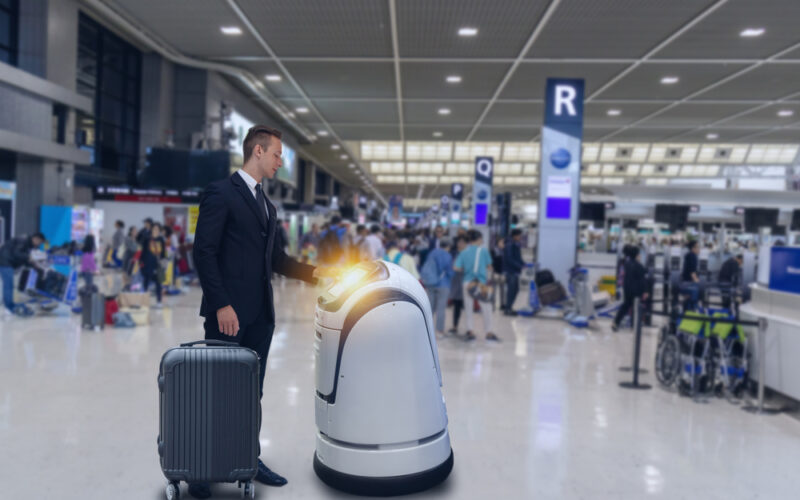As seen in Part 1 of this two-part article, technological innovations are transforming the ways airports operate and also the experiences of passengers traveling through airport terminals worldwide.
So far, AeroTime has examined how the adoption of Artificial Intelligence, biometric technology, and the automation of passenger security checkpoints are all having huge impacts on how air passengers interact with terminal infrastructure and processes.
In this second installment, AeroTime takes a closer look at the incorporation of robotics and automation by airport operators, how the use of the metaverse and immersive experiences are altering the overall passenger experience, and, crucially, how airports are embracing sustainability technologies to meet strict carbon net zero goals in the future – an area that ultimately affects us all.
Robotics and automation
With worldwide labor costs on the rise, an overriding trend that is set to continue at airports is the use of increased automation, using technology to streamline operations, replace human involvement, and offset rising labor costs.
According to a report published by Forbes in 2023, labor has typically represented about 25% of an airport’s cost, with this figure set to rise to around 40% by 2030.
With this in mind, airports are already finding new and innovative ways to introduce more automation to reduce operating costs, not just for the benefit of passengers but across the entire spectrum of airport operations. From cleaning services to passenger processing and from conveying flight information to personal mobility assistance through automated wheelchairs, no area is being left untouched by airport technology innovators.
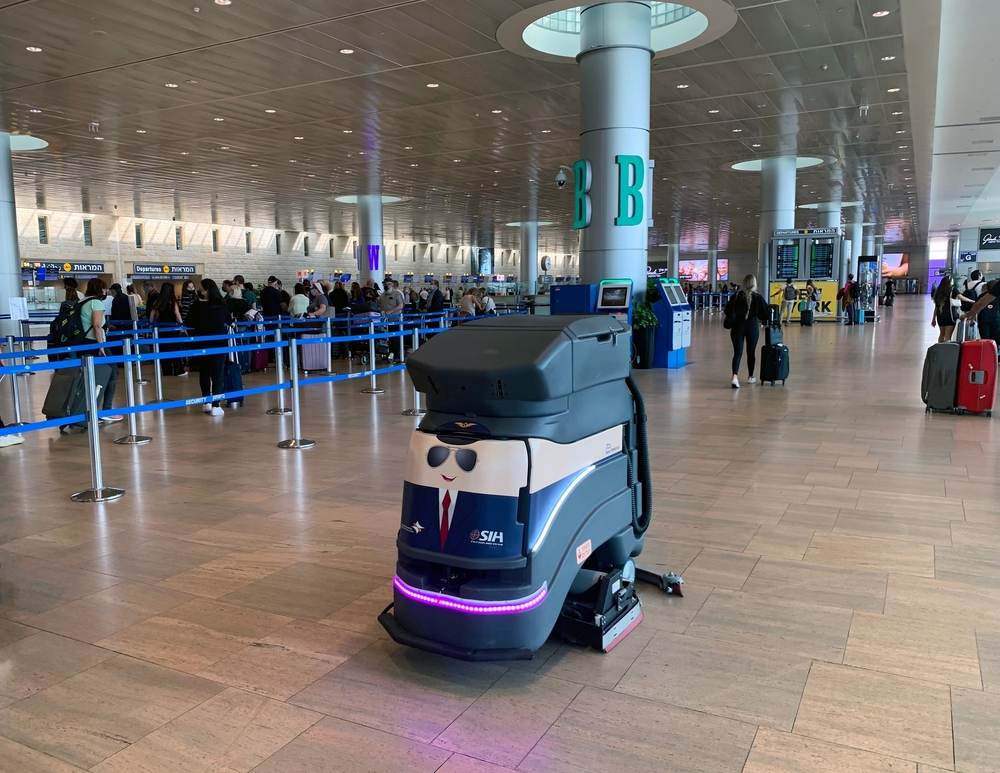
Recent years have witnessed a big acceleration of robotics and automation airside at airports. In 2022, the Royal Schiphol Group outlined how Amsterdam-Schiphol Airport (AMS) plans to achieve a fully autonomous airside operation by 2050. Yet advancements in personal assistant robots are increasingly being introduced for passenger services, too.
Airlines are introducing their own automated robotic assistants to smooth passenger processing and reduce waiting times within busy airport terminals.
Emirates is already utilizing ‘Sara’ – an innovative portable robotic check-in device that can match faces with scanned passports, check-in passengers, and guide them to the bag drop areas at its City Check-in and Travel Stores in Dubai. This reduces the processing time required for passengers when they reach Dubai International Airport (DXB).
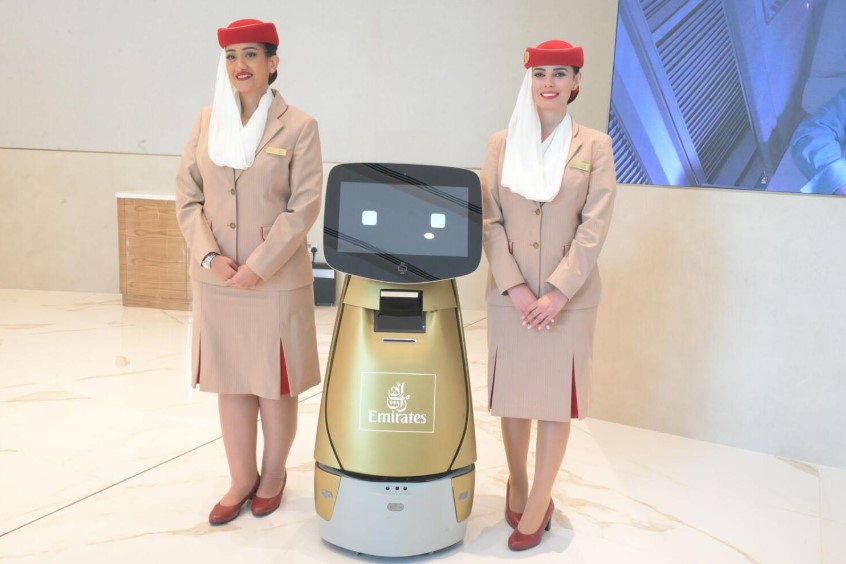
Several other robotic advancements are still in the development stage, including personal assistant robots to be used to provide additional VIP touches in airport lounges and to greet passengers at check-in, for example.
London-Heathrow Airport (LHR) is working in collaboration with global consultancy and construction company Mace, to develop a robotic dog (called ‘Dave’) developed by Boston Dynamics, in a bid to improve efficiency and safety on major construction projects. Using the robot allows the project team to safely retrieve data from building sites, which is then used alongside 3D models and augmented reality to track accuracy and progress on the construction work.
“Heathrow’s vision is to give passengers the best airport experience in the world and, to do that, we need great people, and we also need innovation,” said Emma Gilthorpe, Chief Operating Officer, Heathrow.
“Dave the Dog has been a fantastic innovation enabling us to perform the tasks that we need to do – using robotics and automation,” she added.
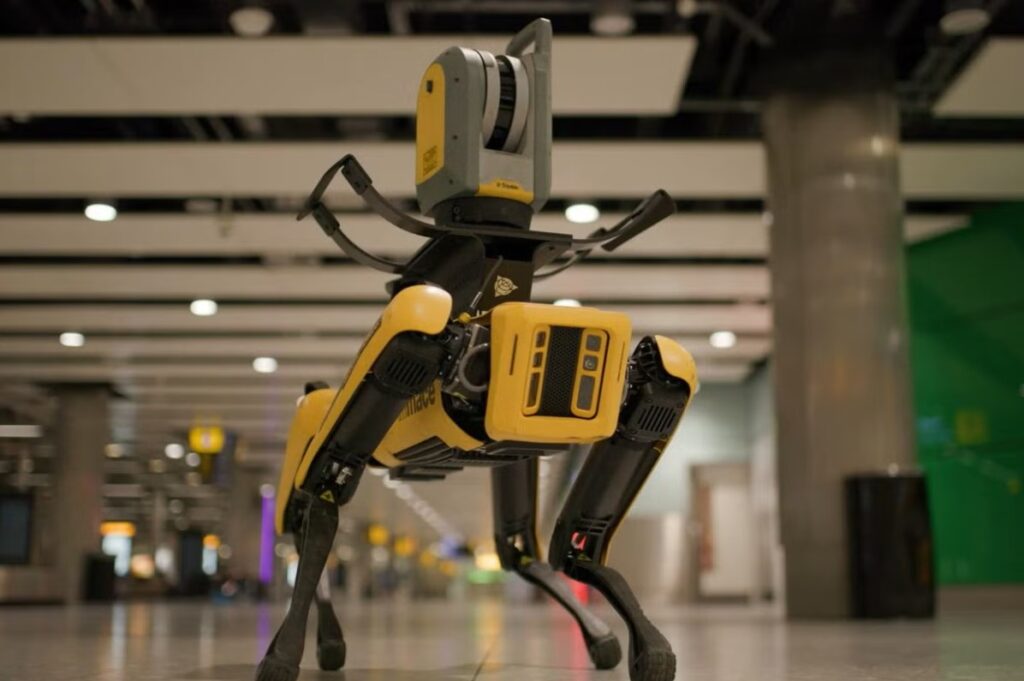
Back on the passenger side, autonomous robots are becoming increasingly commonplace at airports for the delivery of retail and food & beverage products and services. In North America, Cincinnati/Northern Kentucky International Airport (CVG) and Pittsburgh International Airport (PIT) are just two examples that have embraced such technology in several of their terminal food outlets.
Similarly, over in Europe, Aeroporti di Roma (ADR) has adopted a new fully autonomous delivery robot developed by technology startup company Ottonomy.
“We chose automation as one of our topics for our first call for ideas because we truly believe in enhancing passenger experience with a continuous improvement approach,” said Emanuele Cala, VP of Innovation & Quality, ADR.
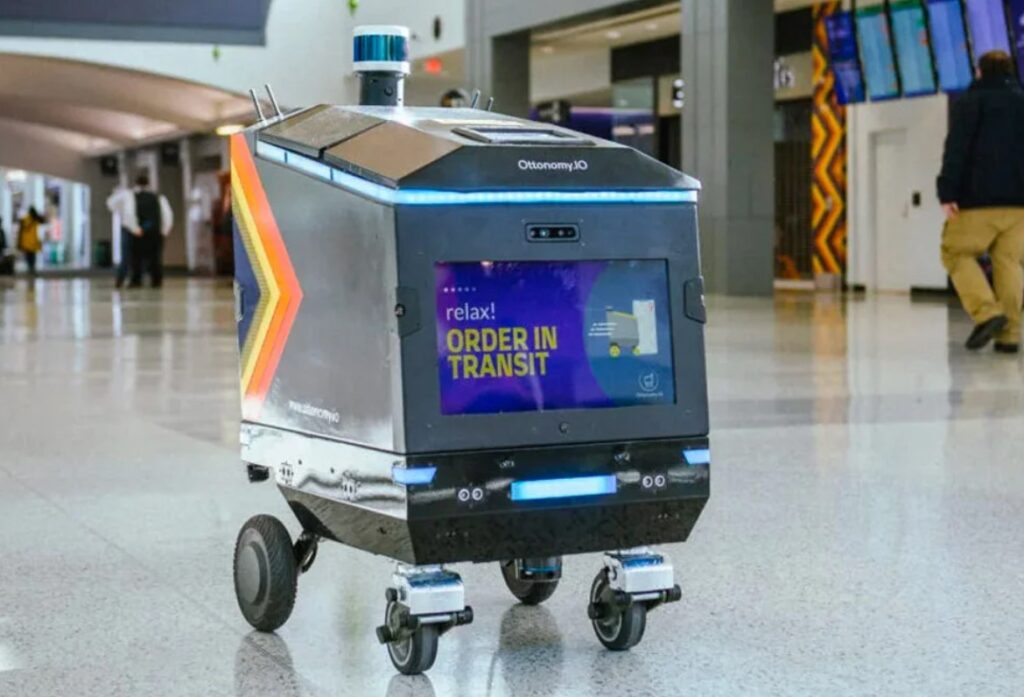
In 2023, PIT and the International Airlines Group (IAG) launched an innovation partnership that will explore exciting new solutions with the robotics and tech community. This will see IAG (which includes airline brands such as British Airways, Iberia, and Aer Lingus) collaborate with Pittsburg Airport’s own xBridge Innovation Center to develop technological solutions to address safety, customer experience, and operational efficiency challenges for both airlines and airports alike.
Metaverse and immersive experiences
The metaverse (defined as an immersive virtual reality experience where people interact with digitally reproduced objects and digital representations of themselves and others) has become a leading area for airport innovation post-pandemic. While the full potential of the metaverse is yet to be realized, airport operators are already identifying opportunities to utilize the metaverse to enhance the passenger experience by adding personalization and offering immersive experiences on their journey through airport terminals.
In its 2023 ‘Meet the Megatrends’ report, SITA highlighted that, “By 2030 metaverse operations will be commonplace at leading airports and play a vital role in optimizing processes, avoiding disruption, and facilitating intuitive, immersive control of intelligent airports.”
There is already real-world evidence that progressive airlines and airports are already exploring the opportunities being presented by the metaverse to enhance the passenger experience.
Bangalore International Airport, the operator of Kempegowda International Airport, Bengaluru Airport (BLR) entered the metaverse in December 2022 with a ‘T2 digital twin’. The syste m (‘BLR Metaport’) was produced in collaboration with Amazon Web Services (AWS) and Polygon, and offers passengers an immersive, 3D virtual experience of the airport’s relaunched Terminal 2.
“We are very excited that BIAL is entering into the new world of metaverse through the BLR Metaport,” said Satyaki Raghunath, Chief Strategy and Development Officer, BIAL at the time. “This is our first foray into the world of Web3 and non-fungible tokens (NFTs), and we aim to delight travelers with a unique, immersive, and virtual experience. We also have several initiatives planned around the BLR Metaport, which promise to increase ways in which we can engage with our global audience and enhance business impact over the next few years.”
Meanwhile, Singapore-Changi Airport (SIN) entered the metaverse in 2023 following the unveiling of ChangiVerse, to revolutionize the online airport experience.
“With our customers becoming more digitally savvy and interacting in the digital space, ChangiVerse is about engaging our customers and serving them better through innovation and experimentation, in line with our belief of customers being at the heart of everything we do,” said Ms Hung Jean, Group Senior Vice President of CAG’s Enterprise Digital Ecosystem & Business Division.
Meanwhile, a contactless retail experience is also being extended to an increasing number of airports. In September 2022, Dallas-Fort Worth Airport (DFW) opened three new sales concessions featuring grab-and-go technology – two featuring Amazon’s Just Walk Out Technology and one powered by Zippin.
One airline using the metaverse which is directly impacting its own hub airport of Doha Hamad International Airport (DOH) is Qatar Airways. The airline has entered the metaverse with the launch of QVerse, a novel virtual reality (VR) experience for visitors on the airline’s website. Users of the site can virtually tour and navigate the premium check-in areas at Hamad International Airport, as well as the cabin interiors of the airline’s aircraft, all by using their own Personal Electronic Devices.
In March 2024, the carrier also became the first global airline to introduce a MetaHuman cabin crew offering a digital interactive customer experience. The holographic virtual cabin crew member, named ‘Sama’, can answer questions in real-time such as airline FAQs, destinations, support tips, and more via the QVerse, as well as through the Qatar Airways app.
Sama was developed by Qatar Airways in partnership with UneeQ, a leader in AI digital human technology to assist its passengers in designing curated travel experiences. The first-of-its-kind cabin crew is also poised to create benchmarks for personalized and functional service interactions in air travel.
“Sama represents our relentless pursuit of innovation and embodies Qatar Airways’ values of exceptional service and hospitality,” said Qatar Airways Vice President Marketing, Babar Rahman in a statement. “This is a monumental point in spearheading the successful synergy between technology and human connection – not only for Qatar Airways but also for the industry at large.”
“Qatar Airways affirms its commitment to leading and collaborating with innovation experts to create pioneering products and services for its customers,” he added.
Elsewhere, as a result of advancing metaverse technology, passengers can expect more immersive retail experiences at airports with the use of Virtual and Augmented Reality technology. Airport retailers, in particular, are taking advantage of advancing technologies to further improve conversion rates and sales.
In November 2021, London-Heathrow Airport partnered with Chanel, Dufry, and JCDecaux to launch a No 5 Spaceship activation in the departure lounge at the airport’s Terminal 5. The immersive experience included a “Find No 5” game for customers, which sells the brand’s fragrance line as well as a curated offering of skincare and cosmetics. An augmented reality (AR) digital screen also allowed shoppers to virtually try on products.
Sustainability
A critical factor affecting the evolution of airports in the future is achieving net zero. In 2008, aviation became the first industry to adopt a global, sector-wide climate action goal.
In 2021, representatives of global aviation industry associations committed to achieving net zero carbon emissions by 2050. To meet this goal, the industry needs to improve energy efficiency and transition to zero-carbon energy and fuel sources. This process will also require input from regulatory authorities if it is to achieve its goal.
Decarbonization, the reduction of carbon emissions, is also a key investor and customer issue. Institutional lenders prefer to fund organizations that have strong environmental, social, and governance (ESG) programs in place, and Gen Z and millennial passengers are showing increasing concern for ESG models. ESG efforts resonate with passengers, with 66% saying they were more likely to purchase from an airline that had enhanced its sustainability efforts.
Across the industry, the air transport sector contributes around 2% of total global carbon emissions. The airport sector specifically is responsible for only a small slice of this, accounting for just 2%-5% of total aviation emissions.
Even though the airport sector contributes a relatively low share of global emissions, airport operators are prioritizing achieving net zero because it recognizes its role as a key enabler in reducing the carbon footprint of the entire aviation system.
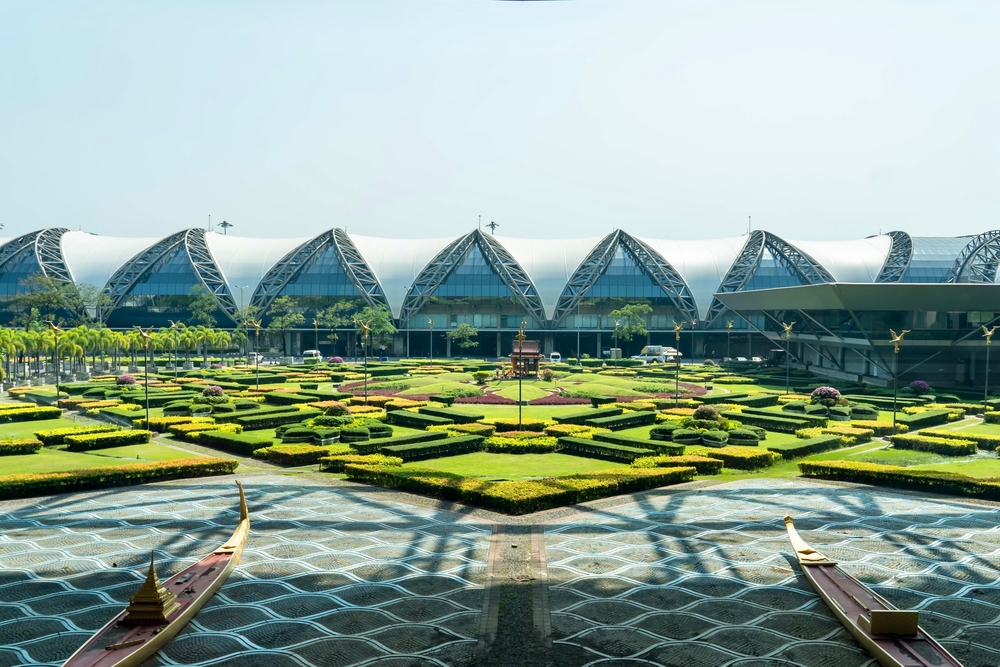
Net zero will only be reached through a combination of initiatives, including Sustainable Aviation Fuels (SAF), new aircraft technologies, more efficient operations and infrastructure, and the development of new zero-emissions energy sources such as electric and hydrogen power. Airports facilitating the availability of alternative fuel sources (such as SAF), and the growing use of electric-powered ground vehicles to cut carbon emissions are all becoming crucial elements of their future sustainability drives.
Increasingly, airports are expected to become energy hubs and energy producers to supplement the resources available on the national grid level and ensure the availability of green energy. Airports will also have to take concerted measures to reduce energy consumption across their ecosystem and utilize negative emissions technologies by either relying on natural processes or employing dedicated technologies such as carbon capture and storage (CCS).
Airports are even poised to become green hydrogen hubs, with hydrogen production serving not only airport vehicles but also the energy demands of the airport itself. There are currently 12 members of the international “Hydrogen Hub at Airport” network, which promotes the further expansion of hydrogen infrastructure in aviation. It is forecasted that airports in the future could generate and consume hydrogen on-site.
One such project is the Hydrogen Aviation Lab that opened at Hamburg Airport (HAM) using the fuselage of a decommissioned Airbus A320. The project is a joint initiative between Lufthansa Technik, the German Aerospace Center (DLR), the ZAL Center for Applied Aeronautical Research, and Hamburg Airport, and is funded by Hamburg’s Ministry of Economic Affairs and Innovation as well as the city’s investment and development bank (IFB Hamburg).
Throughout 2024, the Hydrogen Aviation Lab will be fitted with a full suite of test systems, an internal tank for liquid hydrogen and an onboard fuel cell, paired with supporting ground-based hydrogen infrastructure.
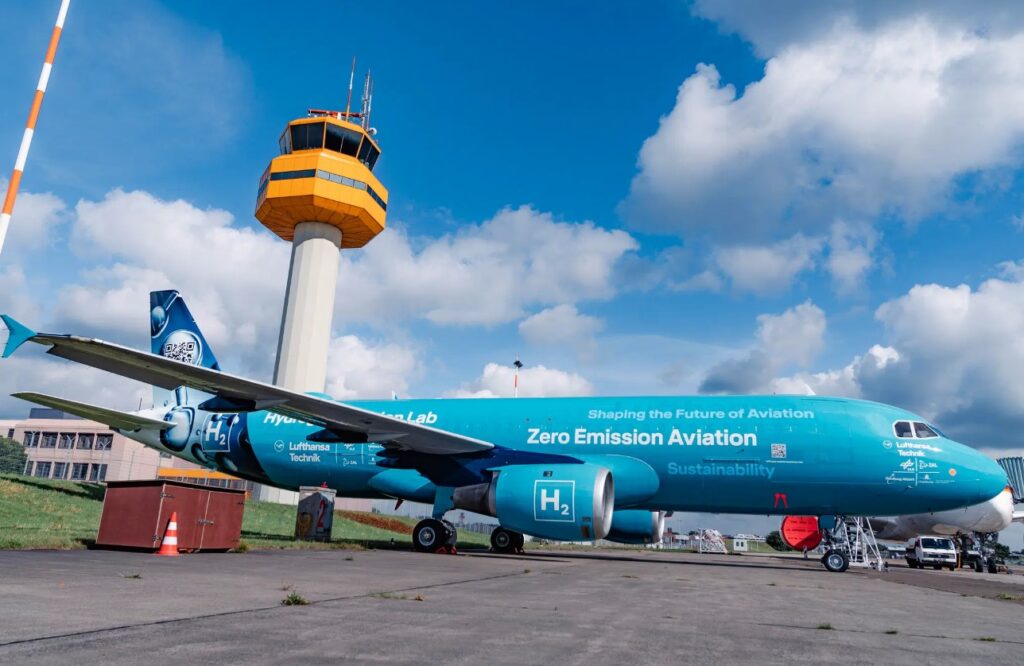
“Climate-friendly flying with hydrogen technology is an important building block for the future of aviation,” said Michael Eggenschwiler, CEO of Hamburg Airport. “Through research projects such as this hydrogen laboratory, we ensure that all aviation partners contribute their experience to the development processes,” Eggenschwiler added.
However, the future of airport sustainability is not just about getting there, but about getting there responsibly. To achieve this in part, airports are transforming into green oases with indoor tropical gardens and rainforests, the addition of solar farms on airport land, growing vineyards on their rooftop spaces, and introducing innovative waste management systems.
For example, green ‘living’ walls are being implemented to reduce temperature and improve air quality at Singapore-Changi and London-Heathrow airports.
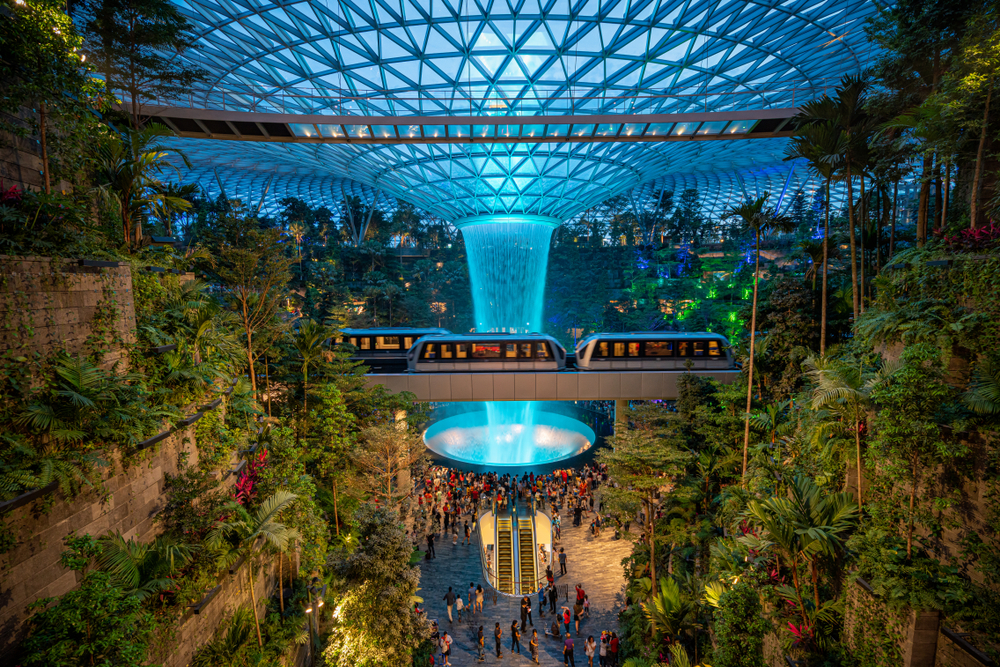
One company assisting airports in reaching sustainability targets is US-based Collins Aerospace. Following the company’s acquisition of FlightAware, a leading digital aviation company providing global flight-tracking solutions, predictive technology, analytics, and decision-making tools, FlightAware became part of Collins’ Connected Aviation Solutions business unit. This unit is exclusively focused on advancing its connected ecosystem solutions.
“FlightAware started as a flight tracking company, but we have now positioned ourselves as an aviation insights company, as we have stored every piece of data that we have captured over the years and that allows us to do a lot of analytics, machine learning and generate new data,” said Paul Gibbson, Vice President Products, of FlightAware at the time of the acquisition in 2022.
“It’s a unique position that we’re in as we have a lot of historical data, we also use live data coming from our network and then we use machine learning to predict the future. The Collins acquisition allows us to expand and accelerate what we do in terms of the impact. It allows us to deliver a lot more in terms of efficiency, sustainably, and reliability, combining the best data with the best applications,” Gibbson continued.
By centralizing aircraft data into one solution, Collins Aerospace intends to increase trust and provide the right information to the right user at the right time. It expects FlightAware to achieve this with more accurate data and clear common visibility. Working with cloud provider Amazon Web Services, Collins Aerospace also argues that this tech is cost-effective as the cloud-based solution doesn’t require the maintenance that large amounts of airport-based hardware do in airports’ traditional core operations room setup.
Summary
Over both parts of this article, it is clear that a journey through an airport terminal building in the future is likely to offer a very different experience to one that travelers are currently used to. Every aspect of the passenger’s airport experience is coming under scrutiny by innovators keen to find new ways to smooth their transition through the airport from one end to the other with minimal delay, using as much automation as possible, and with the stress levels of passengers reduced.
At every stage of their airport terminal journey, passengers want as little hold-up as possible. This allows them more time for more enjoyable activities like relaxing, shopping, eating, and drinking.

Ultimately, airports want happy customers, as they are more likely to use the airport and its facilities again. Returning customers means reduced marketing spend per head for the airport operator, while positive word-of-mouth recommendations can result in higher overall usage – a goal that almost every airport authority strives for.
The adoption of technological advances as they become available will help to achieve these aims for airports.
What are your views on the areas of innovation covered in this article? Have you any experience of any of the technologies discussed? Share your thoughts in the comments below.

